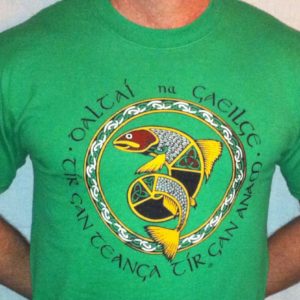Forum Replies Created
-
AuthorPosts
-
Seosamh2012
ParticipantHere (in bold) are the standard Irish equivalents…
a d’ìoc mè leis an ~.
a thug mè don ~.what is the literal translation in English please and when is this form usually used?
grmaSeosamh2012
ParticipantYou might also try the VIFAX program at Maynooth College:
http://www.nuim.ie/language/vifax/Fáilte romhat chuig Vifax 2011-2012! Ar an leathanach seo gach Máirt beidh fáil agat ar chleachtaí Gaeilge bunaithe ar mhíreanna as Nuacht TG4 ón tráthnóna …
SéamusIs the dialect always C.O. or do the reporters use other dialects?
grmaSeosamh2012
ParticipantYou might also try the VIFAX program at Maynooth College:
http://www.nuim.ie/language/vifax/Fáilte romhat chuig Vifax 2011-2012! Ar an leathanach seo gach Máirt beidh fáil agat ar chleachtaí Gaeilge bunaithe ar mhíreanna as Nuacht TG4 ón tráthnóna …
SéamusGo raibh maith agat
Seosamh2012
ParticipantIf you’re a total beginner, you might want to start out with something a little easier at first.
Maybe something like this:http://www.cdu.mic.ul.ie/rabhlai/sampla.htm
You can listen to it by clicking on the icon where it says “Éist”
That is very good, grma
Ideally I am currently looking for radio broadcasts with accompanying transcripts where I can follow the speakers.Seosamh2012
Participanthttp://gaelsceal.ie/index.php?option=com_content&view=section&layout=blog&id=58&Itemid=429
go raibh maith agat.
Where is the transcript to the audio, please, I didn’t find that.Seosamh2012
ParticipantAny native speakers here interested in making videos to accompany the dialogs in http://people.fas.harvard.edu/~hillers/BUNTUS-1.pdf ?
This may be of interest: there is a Buntús Cainte series at [url=http://www.raidiofailtearis.com/category/ceachtanna/]Raidió Fáilte [/url].
Seosamh2012
ParticipantBoth recordings present sounds that aren’t right here.
The first one (broad) is pronounced a bit trilled, while it shouldn’t.
Thanks for your comments.
Is that particular to a certain Canúint by any chance?The second one is plain wrong, she makes a trilled r while it should be a y-sound… But maybe she’s pronouncing another word? It’s hard to believe that someone can make such a mistake (pronouncing r instead of a y-sound). Maybe she says “dàrèag”, which means “twelve (people)”…
The section is “Twelve plus object” then follows the audio.
But if I am not mistaken she is saying dógrma
Seosamh2012
ParticipantHow would dhún sí be pronounced?
[ˈɣuËnʲ ʃi]
on the audio I am using the sound seems very close to /Ê/
close but not the same.
here is the audio:
[url=http://www.fileswap.com/dl/kgFli6vcRo/dhin_s.mp3.html]dhúin sí – 127.8 KB[/url]Another example by the same speaker: (twelfth) dó dhéag /Ê€/
if he says [Ê€], it’s not pronounced properly. Dó dhéag is pronounced [dÉ” ˈjeËg] in native Irish.
audio:
[url=http://www.fileswap.com/dl/EHk0F1S9Zo/d_dhag3.mp3.html]dó dhéag – 61.68 KB[/url]grma
Seosamh2012
ParticipantYes, you’re absolutely right, a Sheosaimh. The broad and slender “gh”/”dh” are two very different sounds. The former resembles the “g” sound in the Spanish word “agua” or the French “r”. Gargling is a good analogy, too. smile The slender version is very similar to “y” in “yeast”. I think that description goes for all dialects, but perhaps Lughaidh and other experts can provide more information…
it is the same sound as in Spanish “agua” (given you know how to pronounce it properly). It sounds a bit like the French r but actually the Irish broad gh/dh is pronounced further forward.
Broad gh/dh is like a hard g (as in “to go”) but instead of stopping the air you leave it pass through between your back palate and your tongue.
But listening to it is the best way 🙂Now for slender gh/dh you used the symbol [Ê] but in my opinion it’s [j] most of the time in Irish, ie. the very same sound as English y.
[Ê] is the voiced form of the sound of slender ch ([ç] in IPA), so it’s a bit different.How would dhún sí be pronounced?
on the audio I am using the sound seems very close to /Ê/Another example by the same speaker: (twelfth) dó dhéag /Ê€/
Here is a link to an IPA audio sample chart of these consonants:
http://www.yorku.ca/earmstro/ipa/consonants.htmlSeosamh2012
Participant.
Seosamh2012
Participanteg. as alt being “out of order,”
what would be the customary phrase for the opposite meaninggrma
Seosamh2012
ParticipantA Chairde
IPA is not associated with any particular language; it is an International Pronunciation standard which can be applied to all languages, thus its usefulness and efficiency in providing equivalency between pronunciations (eg. in the link provided there is a table of how the various Canúintí interpret phonemes).
Naturally it depends on the individual, whatever is working best toward fluency.
dar liomsa
Seosamh2012
ParticipantA Chairde
I agree that the most important aspect is to be understanding and speaking Irish.
Regarding reading,
since the phonetics of Irish spelling works much differently than English,
there seems to be no way for a learner to escape creating a table of sounds, whether one invented by oneself or some other table. IPA is a table with the exact sounds of Irish. Once those symbols are learned and associated with the written Irish a person can read Irish texts and be practising the sounds. It is not very difficult to learn these symbols. There are 34 symbols to learn.http://en.wikipedia.org/wiki/Wikipedia:IPA_for_Irish
Other simplified phonetics still require the same learning process (eg. how is phonetic ‘a’ ‘j’ etc pronounced)
Since IPA is more exact and is a standard there is no question as to the pronunciation.
Eg. a trilled ‘r’ /[size=4]É¾Ë [/size]/dar liomsa, is nach foghlaimeor mé
Seosamh2012
ParticipantThere’s no way to delete a post?
grma
Seosamh2012
ParticipantI meant [dÉ”] but sometimes people pronounce [dÉ™] as well.
grma
-
AuthorPosts
